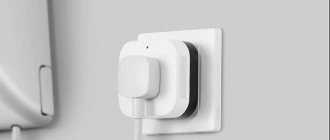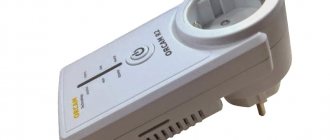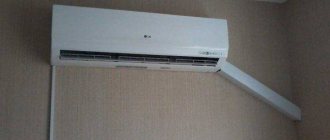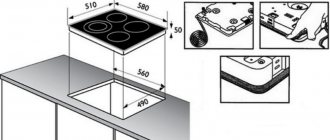Varieties and characteristics
The principle of operation of the socket is the same, the only thing that differs between the models is their design. Manufacturers provide overhead and built-in models. Even at the stage of planning your home, it is important to decide which outlet will be used.
Invoice
Looks like an adapter with one connector.
The design assumes the presence of the following components: indicator, switch button, wi-fi module, packaged in a plastic case. Some models are equipped with humidity sensors, a timer, and a video camera. This model will easily replace existing sockets and does not require additional repair work.
Built-in
Designed for hidden installation, with installation during repair work. The purpose of this option is to replace an ordinary electrical point. The housing, made of heat-resistant plastic, protects the consumer from the release of harmful halogens. Due to the heat resistance of 748 degrees, manufacturers guarantee the safety of the device.
What is Wi-Fi and how does it work?
Last updated on July 24, 2021 at 10:52 am by David Webb.
WiFi
is a technology that uses radio waves to provide network connectivity.
The connection is established by using a wireless adapter to create access points—areas in close proximity to the wireless router that are connected to the network and allow users to access Internet services. This article will introduce you to the basics of WiFi
so you can better understand your Internet access.
What does WiFi mean?
You might be surprised to learn that many people don't actually know that WiFi
is a shortened term.
There are a number of theories about what this term means, but the most widely used definition of the term in the tech community is Wireless Fidelity
.
Introducing WiFi
Wireless technology is very popular these days and you can connect almost anywhere;
at home, at work, in libraries, schools, airports, hotels and even in cafes and restaurants. The wireless network is known as a Wi-Fi network or 802.11 because it covers IEEE 802.11 technologies. The main advantage of Wi-Fi is that it is compatible with almost all operating systems, gaming devices and advanced printers.
How WiFi works
Like cell phones, Wi-Fi uses radio waves to transmit information across the network.
The computer must include a wireless adapter that will convert the data sent into a radio signal. The same signal will be transmitted through the antenna to a decoder known as a router. Once decoded, the data will be sent to the Internet via a wired Ethernet connection. Because a wireless network operates as two-way traffic, data received from the Internet also passes through the router and is encoded into a radio signal that will be received by the computer's wireless adapter.
WiFi frequencies
The wireless network will transmit at 2.4 GHz or 5 GHz frequency levels to adapt to the amount of data the user sends.
Model 802.11 networking standards will vary slightly depending on the user's needs. 802.11a
will transmit data at the 5 GHz frequency level. The orthogonal frequency division multiplexing (OFDM) used improves reception by splitting radio signals into smaller signals before they reach the router. You can transfer a maximum of 54 megabits of data per second.
802.11b
will transfer data at the 2.4 GHz frequency level, which is a relatively low speed. You can transfer a maximum of 11 megabits of data per second.
802.11g
will transmit data at 2.4 GHz, but can transmit a maximum of 54 megabits of data per second since it also uses OFDM encoding.
More advanced 802.11n
can transmit up to 140 megabits of data per second and uses a frequency level of 5 GHz.
Here's a detailed guide to the latest Wi-Fi 6 technology and a more detailed explanation of the different types of Wi-Fi.
What are access points?
The term hotspot
is used to indicate an area where Wi-Fi access is available. This can be either through a closed wireless network at home or in public places such as restaurants or airports.
To access access points, you must have a wireless adapter installed on your computer. but most laptop models in 2021 already have a built-in wireless transmitter. If this is not the case, you can purchase a wireless adapter that will plug into a PCI slot or USB port. Once installed, your system should automatically detect Wi-Fi access points and request a connection. If not, you should use software to do this task for you, an example of which you can find here.
Connect to WiFi via modem
To establish a connection with a wireless router, you must first make sure it is connected to an Internet connection point.
Turn on the external modem before connecting the router to your computer via an Ethernet cable. Then turn on your wireless router and open your internet browser. You will be prompted to enter the router's IP address. This IP address will differ depending on the service you use. Belkin users
must enter https://192.168.2.1.. If you are a
Linksys
, enter https://192.168.1.1.
Now enter your router username and password. Set SSID
(wireless capability) as
Active
, and then enter the username and password provided by your ISP and select
WEP
or
WPA
.
Select a new passkey to complete the WiFi setup.
Image: © Pixabay.
.
How does Wi-Fi work from a wall outlet?
Operation is controlled by a built-in microprocessor. The processor coordinates work with a control device - a gadget with an installed application. There are also more complex modifications on the market with network adapters with 4 connectors, but such options are not suitable for everyone.
Wi-Fi from an outlet allows you to perform the following functions:
- Turn electrical appliances on and off from a distance.
- Control the amount of electricity used.
- Reboot electrical appliances.
- Set a timer to control devices.
- The presence of a temperature sensor ensures fire safety.
Before connecting the device, you should make sure that its power is lower than the power of the outlet. Such information is provided in the technical data sheet of the equipment.
What is a WiFi socket?
A smart WiFi socket is a special device that is inserted in place of the old socket and connected to the existing wiring. Then the device is used in normal mode. You can connect household appliances and other electrical consumers to it within the established limit.
Control is carried out through an application installed on a smartphone, with which you can remotely turn on and off the power. Some manufacturers offer models with advanced functionality. For example, you can find smart WiFi sockets with a temperature sensor or current consumption data on sale.
In general, it seems that wireless communications are already everywhere, starting from the usual adapters in laptops to a special option for phones called WiFi Calling.
The principle of operation of a “smart” wi-fi socket
When connecting an outlet to a router, the device receives a unique IP address. An assigned address allows you to communicate with other objects via the Internet. The signal is encrypted, which helps protect the device from unauthorized access. Settings are stored on the server or device. In the first case, statistics and data are stored reliably, but in the second, if the connection is broken, they will need to be restored.
The programs are freely available and can be installed on a control device - any modern gadget.
With air temperature sensor
A device with a temperature sensor will cost more than other alternatives, but it will provide security for your home. The sensor takes measurements and monitors ambient temperature indicators. If an excess of the norm is recorded, which may cause a fire or short circuit. The smart device will instantly disconnect the devices from power and send a message to the owner of the smartphone.
Real alarmists will always be aware of the state of the appliances in the house and will not have to worry whether everything is turned off or not.
Smart home control
The concept of a “smart home” appeared a long time ago.
The owner of such a house controls the equipment using a program installed on the phone. To start using the outlet, you need to create an account in the cloud, which is recommended by the manufacturer. If this is not done, then only basic functions will be available to the user - turning electrical appliances on and off. Additional functionality will be available after registration.
After launching the application for smart devices, the gadget is added. Each smart plug is labeled with a name and an image is uploaded. This approach makes it easier to navigate around the house, especially if there are a lot of such devices.
Some models can be controlled using the popular voice assistants Amazon Echo and Google Home. But the commands are given in English. Smart home control allows you to create a schedule and enable the “Away” mode, which allows you to simulate the presence of the owners in the house when they are actually not there.
Devices often track energy consumption indicators, which allows you to make forecasts on the costs of this resource. Such a smart device allows you to control other devices, making life more comfortable.
The need for smart plugs
People who are not familiar with the advantages of the device classify it as an expensive toy. To understand its value, you need to understand how a smart plug works and what it can do. In addition to turning on and off the power supply, working in conjunction with other equipment, the device turns into a multifunctional gadget that improves everyday life. When used correctly, the relatively high price of smart sockets is justified by their return on investment. The devices rationally distribute energy consumption, ensure safety, and relieve the owner from unnecessary household chores.
Advantages over conventional
To be convinced of the advantages of a smart socket, just compare it with a regular one (Table No. 1).
Tab. No. 1
| Regular | Smart |
| Low price | Multifunctionality |
| Easy to connect | Remote control |
| Control of energy consumption | |
| Overload protection |
What Wi-Fi devices can do
Smart Wi-Fi sockets provide the owner with a lot of possibilities, presented by:
- remote connection and disconnection of household electrical appliances;
- ensuring fire safety;
- control of consumed electricity;
- working in timer mode;
- the ability to reboot office equipment, etc.
Devices connected to the router have a personal IP address, which opens up the possibility of remote control using mobile devices.
How to set up and connect
Before connecting a smart socket, you must read the instructions included with the gadget. Despite the similarities, the configuration of devices from different manufacturers differs in some nuances. At the same time, it is mandatory for all models of smart sockets. You must install the appropriate application for iOS or Android OS on the control gadget. In general the process looks like this:
- Pairing the device with your home Wi-Fi network is followed by scanning a unique QR code and access to download programs opens.
- When the application is open, the “Search for a new network connection” option is activated. After connecting to your home access point, enter the password in the tab that opens.
- The smart socket connects to a 220V network. To turn it on, you must hold the “On/Off” button. for 4–6 seconds. Activation of the device is accompanied by flickering LED indicator.
- After finding the corresponding socket on the gadget, it is added to the list of devices.
When properly connected, the smart socket is ready to connect household appliances, each of which must be configured individually.
Returning the smart socket to factory settings is done by pressing and holding the “On/Off” button. about 5 seconds.
Interface for Xiaomi sockets
The undeniable advantages of Xiaomi smart sockets include an accessible interface:
Before managing a smart plug, you need to enter the “Mi Home” section and select the appropriate device. In this case, you need to make sure that you are connected to your home Wi-Fi, Bluetooth and GPS network. To activate a particular function, the corresponding icons and inscriptions are used:
- Clicking on the “Socket” icon turns the device on and off;
- Using the “Clock” icon, you can set the operating time of the device.
- The Timer icon enables the countdown function.
Depending on the model of the Xiaomi outlet, it becomes possible to set up scenarios and pair it with devices included in the Smart Home equipment. The combined operation of a smart socket with temperature and humidity sensors, as well as a connected air conditioner, allows you to control the home microclimate without external intervention.
More detailed information about managing the Xiaomi smart socket can be found by watching the video review:
How to manage sockets from Yandex
The Wi-Fi outlet allows remote control using voice commands. For this purpose, the Russian-language voice assistant “Alice” is used. The process is carried out as follows:
- The Yandex application opens.
- The connection of the outlet to the account is verified.
- In the “Devices” section, select “Management”.
- After clicking on the “Socket” item, the device is ready for use.
A smartphone, smart speaker and other gadgets compatible with Alice can be used as a control device.
Video:
Features of using other models
Radio sockets are also used to remotely connect and disconnect household appliances to the network. Such devices are not multifunctional, but do not require additional equipment. The standard kit includes a smart socket with a receiver and remote control operating at frequencies of 315–433 MHz.
Operating rules
The socket operates in the range of 100 - 240 V, with an output power of 2 to 4 kW.
Such parameters allow you to connect devices with large short-term loads. We are talking about heaters or a food processor. Each manufacturer provides individual instructions for the devices, but their operating principle is the same. The only difference is the presence of additional functions.
Install a special application on your gadget and check your Internet connection.
The software is selected by the QR code on the packaging from the outlet.
You need to set the device search in the program. To connect, enter a special password. Only after this the wi-fi device will be connected to the network and ready for use.
After making all the settings, connect the device, which will work from the outlet. Individual settings for each device are carried out according to the instructions for the device. To ask for settings, press the on/off button for six seconds.
Connection and setup
There is nothing complicated about this, since all control and configuration will be carried out through the application.
- Download the app for your socket from Google Play. There will be a QR code in the box under the socket that will help you quickly find the program you need. But you can simply enter the name of the company that produced the device in the search bar.
- We connect the outlet to your standard one.
- Open with the app on your phone. If you are asked to create an account, create and log in.
- Next, the system will ask you to connect to a Wi-Fi outlet. After this, you just need to act according to the instructions given.
- Finally, we connect the device to your home router.
The setup system may differ slightly from one firmware to another and from one company to another, but in general everything is quite simple. The most important thing before this is to choose the right device.
It is much easier to control electrical appliances if there is a Wi-Fi outlet in the house. This device operates on the principle of wireless connection with a control device (desktop computer, mobile phone, tablet, laptop).
Advantages and disadvantages
A modern device allows you to control the operation of equipment in your home from a distance. Other advantages include:
- Additional functionality in the form of a timer or backlight.
- Control one point from 40 gadgets.
- Easy to operate and install.
- Optimal sizes.
- The presence of a temperature sensor, made of fire-resistant material.
- Reception range from 50 meters.
The disadvantages of the modern device include:
- When the power goes out, all settings are lost.
- Some models may not be compatible with the router.
- The Wi-Fi outlet reacts to its time zone, which is worth considering when choosing a manufacturer.
- In the event of an emergency, the device turns off.
- Without an Internet connection, it is impossible to control the outlet from a distance.
Flaws
Outlets are part of the Internet of Things (IoT). Consequently, hackers will make attempts to break into the equipment. We assure people who are little concerned about the problem: if you avoid harming your own household, you will harm someone else’s.
The inconveniences become obvious:
- An increase in mechanical leverage contributes to the loosening of fastenings and sockets by random factors.
- Raised background noise near Wi-Fi devices is harmful to people's health.
- The equipment loads local network traffic.
- It is necessary to keep the router turned on at all times; sometimes the hardware freezes, killing the service completely. Rebooting the router remotely is very difficult. The use of remote access protocols violates the safety of equipment operation.
- The devices are expensive.
- There is absolutely no consideration of Russian specifics.
- The habit of leaving appliances on, hoping for smart technology, can end badly.
Socket with Wi-Fi control: service life
Each manufacturer indicates a warranty period. Such models work no less than conventional sockets. If necessary, they can be easily dismantled and new ones installed. Chinese models will work for up to a year, but European manufacturers provide a guarantee for three or even more years. In reality, the actual service life of such sockets is much longer. Therefore, it is worth choosing a model that is a little more expensive, but the quality of the materials promises a long service life.
A Wi-Fi outlet is a part of a smart home, which is designed to ensure maximum comfort for residents. The device is a simple example of home automation, which has become more popular in recent years. The task of the outlet is to fulfill three assigned functions - ensuring safety in the house from unauthorized ignition, ensuring energy savings and increasing comfort conditions.
The devices are presented in two models – overhead and built-in, which are selected taking into account the needs of the consumer. The operating principle is simple, and installation does not take much time. The money spent will be worth it and everyone will be delighted with the work of the Wi-Fi outlet.
How WiFi works | HowStuffWorks
If you already have several computers on your network, you can create a wireless network using an access point. If you have multiple computers that are not connected to a network, or if you want to replace your Ethernet network, you will need a wireless router. This is a single block that contains:
- Port for connecting to a cable or DSL modem
- Router
- Ethernet hub
- Firewall
- Wireless access point
A wireless router allows you to use wireless signals or Ethernet cables to connect computers and mobile devices to each other, to the printer, and to the Internet. Most routers provide coverage of about 100 feet in all directions, although walls and doors may block the signal. If your home is very large, you can buy inexpensive range extenders or repeaters to increase the range of your router.
Announcement
As with wireless adapters, many routers can use more than one 802.11 standard. Typically, 802.11b routers are a little cheaper than others, but because the standard is older, they are also slower than 802.11a, 802.11g, 802.11n, and 802.11ac. 802.11n routers are the most common.
Once your router is connected, it should start working with default settings. Most routers allow you to use a web interface to change your settings. You can choose:
- The name of a network, known as its service set identifier (SSID).
— The default is usually the manufacturer's name. - The channel that the router uses.
- Most routers use channel 6 by default. If you live in an apartment and your neighbors also use channel 6, you may experience interference. Switching to another channel should fix the problem. - Your router's security settings
- Many routers use a standard public login, so it is recommended to set your own username and password.
Security is an important part of your home wireless network, as well as public Wi-Fi hotspots. If you set your router to create an open access point, anyone with a wireless card can use your signal. However, most people would prefer to keep outsiders away from their networks. To do this, you need to take some security measures.
It's also important to make sure your security measures are up to date. Wired Equivalency Privacy (WEP) was once a WAN security standard. The idea behind WEP was to create a wireless security platform that would make any wireless network as secure as a traditional wired network. But hackers have discovered vulnerabilities in the WEP approach, and today it is easy to find applications and programs that can compromise a WAN that uses WEP security. It was replaced by the first version of WiFi Protected Access (WPA), which uses Temporal Key Integrity Protocol (TKIP) encryption ) and which is an improvement over WEP, but is also no longer considered secure.
To keep your network private, you can use one or both of the following methods:
- Wi-Fi Protected Access version 2
(WPA2) is the successor to WEP and WPA and is now the recommended security standard for Wi-Fi networks. It uses TKIP or Advanced Encryption Standard (AES) encryption, depending on what you choose during setup. AES is considered the most secure. As with WEP and initial WPA, WPA2 security requires login with a password. Public access points are either open or use any of the available security protocols, including WEP, so be careful when connecting outside the home. Wi-Fi Protected Setup (WPS), a feature that associates a hard-coded PIN with the router and simplifies setup, apparently creates a vulnerability that can be exploited by hackers, so you may want to disable WPS if possible, or look into routers which have no function. - Media Access Control
(MAC) address filtering is slightly different from WEP, WPA or WPA2.
It doesn't use a password to authenticate users—it uses the computer's physical hardware. Each computer has its own unique MAC address. MAC address filtering allows only machines with specific MAC addresses to access the network. You must specify which addresses are allowed when configuring your router. If you buy a new computer or visitors to your home want to use your network, you will need to add the new computers' MAC addresses to your list of allowed addresses. The system is not secure. A smart hacker can spoof
a MAC address, that is, copy a known MAC address, to fool the network that the computer he is using belongs to the network.
You can also change other router settings to improve security. For example, you can configure WAN request blocking to prevent the router from responding to IP requests from remote users, set a limit on the number of devices that can connect to your router, and even disable remote administration so that only computers connected directly to your router can change your network settings. You should also change the Service Set Identifier (SSID), which is your network name, to something other than the default so that hackers can't immediately tell which router you're using. And choosing a strong password never hurts.
Wireless networks are easy and inexpensive to set up, and most routers' web interfaces are virtually self-explanatory. For more information about setting up and using a wireless network, follow the links on the next page.
.
How to use: operating instructions
- Before you start using a smart device, you need to study the capabilities of the model.
- It is recommended to use radio-controlled devices in rooms with low humidity. Signal reception may deteriorate if metal objects or medical equipment (for example, a pacemaker) are nearby.
- It is better to buy devices with a GSM module with a standard backup battery - this will help save settings during a power outage.
- Sockets with a wi-fi module are configured so that the parameters are saved on the server. Otherwise, if there is a power outage, the settings will be reset. Sometimes the time zone may not coincide with real time, so this parameter must be set independently. If there is no Internet connection, the device stops working.
Functions
The functionality is quite wide, but in general everything is limited to the banal switching on and off of electricity. I’ll immediately note the price - the price range in the store is wide: from 1,500 rubles to 10,000 rubles. Below in the article I will present several models and tell you how they differ from each other.
There are also models that have motion, smoke, humidity, temperature, etc. sensors. Such models will help you quickly understand what is happening in your apartment. It is clear that they cost much more. A standard model with regular Wi-Fi costs from 1,400 to 2,500 rubles.
Here is the entire list of functions. But the functions may differ greatly from one model to another.
- Turning power on and off on connected devices;
- Control via smartphone or tablet, via application;
- Smoke and air sensors will help you quickly detect a fire and call the fire department;
- Motion sensors will be able to understand about uninvited guests;
- Child control to turn off the TV, computer and lights.
- Built-in timer, can be configured to turn devices on and off according to time. Well, for example, turn off or, on the contrary, turn on the light at night and during the day.
- Ability to see power consumption.
How to choose?
First of all, you need to roughly understand what exactly you will be plugging into the outlet. The load and current power will depend on this. If you will use the outlet in the garage or where there may be sub-zero temperatures, then you should consider buying models with IP protection against moisture and dust. Well, of course, the operating temperature must be appropriate.
For permanent devices, it is better to take a built-in socket, but a regular block socket will not be bad either. Well, at the very end, start from the price. There are a lot of models. If you don’t need bells and whistles with motion and temperature sensors, then take a regular Wi-Fi socket.
Control method
We have already discussed the main control methods, these are:
- Wi-fi smart socket that is controlled using a program on the phone;
- For radio sockets, a remote control is used;
- It has a GSM socket and receives commands via SMS and calls from the phone.
For example, a wi-fi socket is better suited for a home, a GSM socket for a summer residence, and in an area without access to various networks. All that remains is radio equipment.
Maximum power
An outlet has limits on how much electricity it can pass through. And if the consumption is too high, the device may fail.
Plug standard
Everything is simple here if you have a device with a non-standard plug, and you do not want to make the design more bulky and use adapters. Then you should select a socket with a suitable plug in advance.
Connection type
The device is installed either directly into an outlet or is part of an electrical panel.
Functionality
Smart plugs have many additional features, for example:
- Smart socket with temperature sensor
- Surge protection;
- Availability of protection from dust and moisture;
- Ability to record various operating algorithms;
- Availability of notifications in case of problems;
- Tracking the amount of electricity consumed.










